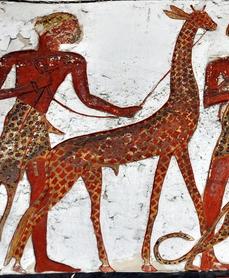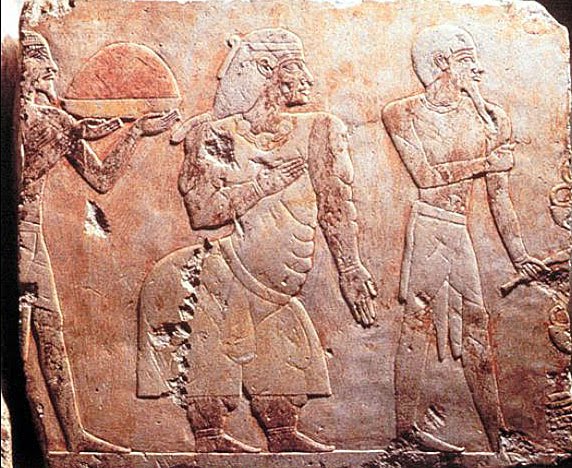The First Pictured Sub Saharan African? November 19, 2013
Author: Beach Combing | in : Ancient , trackbackIt would be untrue to say that the woman portrayed above is the first Sub-Saharan African to be reproduced by an artist, as there are various cave paintings pre-dating this work by several thousand years, some in the Saharan desert itself. But this is to the best of my knowledge: drbeachcombing at yahoo dot com – the first surviving historical portrayal of a Sub-Saharan African: a real person placed in a real historical context rather than the ‘dreaming’ lines of the cave works. We are in the reign of Hatshepsut (obit 1458 BC), the female ‘king’ of Egypt (the first woman we know who took this role) and Hatshepsut’s proudest boast in her beautiful temple at Deir el-Bahri is that she organized a trading expedition to mysterious Punt: note that there is no suggestion that she actually went on this mission, it was led instead by Senenmut, a high official and possibly Hatshepsut’s lover. Punt is ‘mysterious’ because no one is clear where this land lay: suggestions have been made for both Eritrea or somewhere on the opposite Arabian coast.

The vast majority of scholars favour the African solution simply because of the goods shown in the images at Deir el-Bahri: not just incense and the like, but also giraffes, baboons and other African exotica. The housing in the images also suggests Africa: enjoy the details below; love the bird!
The writing in the temple reliefs are clear that Punt was ruled by one King Parahu and Queen Ati. The king is also portrayed above, but it is Ati that gets our attention and keeps it. What is wrong with her body? Does she suffer from some horrific disease: elephantiasis has been suggested and one scholar has even coined ‘the Queen of Punt syndrome‘. Or were Egyptians simply trying to portray an unusually heavy Eritrean woman: remembering that in some cultures (from early modern Ireland to many of the Pacific islands) fatness was seen as a virtue particularly among ‘the heavier sex’? Was she really as important as the picture suggests? Or was Ati just one of many concubines of the King, perhaps elevated by the Egyptian need to spot a Great Wife to equal their own Hatshepsut among the Africans and their own notions of female blood carrying nobility and royalty? We cannot know and we will never know but Beach with his historical novelist mind (ahem…) likes to think of Senemet and Hatshepsut lying back after some energetic coitus and he describing this large and impressive woman that he saw far to the south, in the land beyond the Nile and Hatshepsut closing her eyes and imagining with him. Oh to have been there: that is in Punt not Hatshepsut’s bed.
23 Nov 2013: Judith W from the Zenobian blog writes in I would never think of Eritrea as ‘sub-Saharan’: though it is south of the desert, it is also very far away to the east. No matter. For new information on the location of Punt and the image of its queen Eti (or Ati), see my blog post [I wish I’d seen Zenobia’s post before I’d written mine]More likely to be sub-Saharan — perhaps Libyan or at least Nubian, are the black warriors on the ‘Captain of the Blacks’ fresco fragment from Knossos. While this could be a little later than Hatshepsut (perhaps first half 14th C BCE), the theme of dark-skinned warriors already appears at Knossos by the end of the Middle Bronze Age in the so-called ‘Town Mosaic’; sorry, I have no good picture: you’ll have to take my word for it.*** Michel writes: Steatopygia comes to mind: . See here for a well-known extreme example that could almost double for the Egyptian picture: BUT: steatopygia is a genetic anomaly restricted to people native to Southern and to some extent Central Africa (in South Africa, you can walk down any busy street to see examples, though not quite that extreme). It is unknown among the tall, skinny people of the Horn of Africa . Which makes one wonder, just how far south did that expedition go? *** Borky reflects, meanwhile: Beach allowing for cultural biases of artists’s eye remarkable resemblance to this lady’s physical type Definitely African quite possibly not diseased at all merely decades of easy livin’/boredom alleviated by hearty scoff*** Thanks Borky and Michel and Zenobia!




